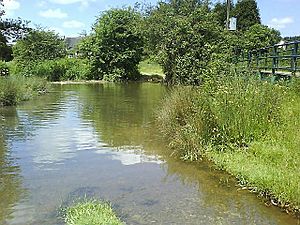Freeman's Marsh facts for kids
| Site of Special Scientific Interest | |
 |
|
| Area of Search | Berkshire |
|---|---|
| Interest | Biological |
| Area | 25.1 hectares (62 acres) |
| Notification | 1986 |
| Location map | Magic Map |
Freeman's Marsh is a really special natural area covering about 25 hectares (that's like 50 football fields!) on the edge of Hungerford in Berkshire. It's called a Site of Special Scientific Interest (SSSI) because it's super important for its wildlife and plants. This amazing place is also part of the North Wessex Downs, which is a beautiful Area of Outstanding Natural Beauty. The Town and Manor of Hungerford look after this site.
Contents
What Makes Freeman's Marsh Special?
Freeman's Marsh is a biological SSSI, which means it's recognized for its important plants and animals. It's located in the flood plain of the River Dun, a river that flows right through the area. Being in a flood plain means the land can sometimes get covered by water when the river overflows.
Amazing Habitats
This special marsh has many different types of natural areas, called habitats, where various creatures live.
- Unimproved Meadows: These are grassy fields that haven't been changed much by farming. They've been managed for a long time by animals grazing there, which helps different kinds of wildflowers and grasses grow.
- Marsh and Reedbeds: These are wet, swampy areas with tall grasses and reeds. They are perfect homes for many birds and insects.
- Scattered Woodland: There are also small areas of trees dotted around the marsh, providing shelter and food for wildlife.
Wildlife at Freeman's Marsh
Freeman's Marsh is a fantastic place for birds, especially those that love wet environments. Many different species come here to nest and raise their young.
Birds of the River and Meadows
You can spot many birds along the river banks and in the marshy meadows.
- Snipe: These birds are masters of camouflage, blending in with their surroundings.
- Little Grebes: Small diving birds that are fun to watch on the water.
- Mute Swans: Large, graceful white birds often seen gliding on the river.
Birds of the Reeds
In the tall fen and reedbeds, you might hear or see other special birds.
- Sedge Warblers: Small, busy birds known for their chattering songs.
- Reed Warblers: Another type of warbler that builds its nest in the reeds.
- Reed Buntings: These birds have distinctive black heads (males) and enjoy living near water.
Visiting Freeman's Marsh
If you want to explore this natural wonder, you're in luck! There are public footpaths that cross through Freeman's Marsh. These paths let you walk through the different habitats and enjoy the peaceful surroundings, giving you a chance to see some of the amazing wildlife up close. Remember to stick to the paths to protect the delicate environment.

